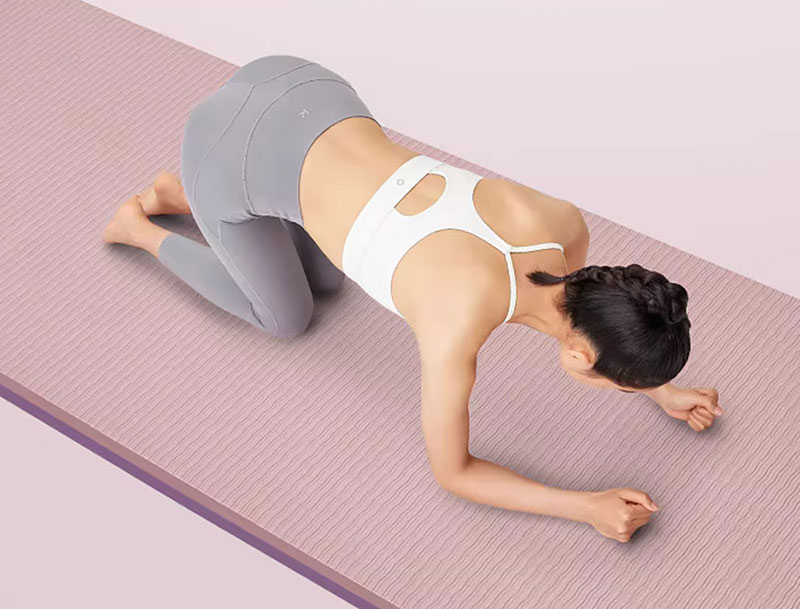So, you’ve decided to embark on a yoga journey. Congratulations! Now, before you roll out your mat and strike that first downward dog pose, there’s one crucial decision you need to make – choosing the right yoga mat. And let me tell you, friend, this decision is not as simple as it may seem.
With a dizzying array of options available in the market, finding the perfect mat can be overwhelming. Therefore, we will guide you through the process step by step so that you can make an informed decision and find your soulmate in a yoga mat.
We’ll explore different types of mats based on your practice level and delve into various materials to consider. We’ll also discuss thickness, cushioning, texture, grip, eco-friendly options, maintenance tips, and even size options because hey – one size doesn’t fit all!
By the end of this article, my friend, you will be equipped with all the knowledge you need to choose a yoga mat that supports your practice and enhances your experience.

Understanding Different Types of Yoga Mats
If you’re looking for a yoga mat that’s as light as a feather and as grippy as a gecko, then consider opting for a natural rubber mat. Natural rubber mats are known for their excellent grip, which can help prevent slipping during your practice. They also provide good cushioning and support, making them ideal for beginners or those with sensitive joints. However, keep in mind that natural rubber mats may have a strong smell initially and require regular cleaning to maintain their quality.
If you prefer more eco-friendly options, cork mats are worth considering. They offer similar benefits to natural rubber mats but with the added advantage of being sustainable and biodegradable.
Difference Size Options
To ensure you find the perfect fit, explore the various size options available for your eco-friendly yoga mat.
Yoga mats come in different dimensions to accommodate different body types and preferences. Standard mats are usually around 68 inches long and 24 inches wide, which works well for most practitioners.
However, if you’re taller or prefer more space, you can opt for an extra-long mat that measures up to 84 inches in length.
For those who like extra width or appreciate a larger practice area, wider mats are available at around 26 inches.
It’s important to choose a size that allows you to move freely and comfortably during your yoga sessions. By considering your height and personal preference, you can make an informed decision on your yoga mat that suits your individual needs without compromising on comfort or functionality.
Considering Your Practice Level
Once you’ve mastered the basics and are ready to deepen your practice, it’s time to level up with the perfect mat for your yoga journey.
As an intermediate or advanced practitioner, you need a mat that can support your more challenging poses and provide better grip. Look for mats that are thicker and have more density to cushion your joints during intense sequences. These mats often come with enhanced traction, ensuring stability even in sweaty conditions.
Additionally, consider choosing a mat with alignment markers or patterns to help improve your form and maintain proper alignment throughout your practice.
Exploring Different Mat Materials
When it comes to finding the perfect mat for your yoga journey, you’ll be spoilt for choice with a wide range of materials that cater to different needs and preferences.
One popular option is a PVC mat, which provides excellent grip and durability. It’s also easy to clean, making it ideal for hot yoga sessions where you might sweat a lot.
Another option is natural rubber mats, which are eco-friendly and provide great cushioning. They have good traction but may not be suitable if you have latex allergies.
If sustainability is important to you, consider mats made from cork or jute as they are biodegradable and offer good grip.
Evaluating Mat Thickness and Cushioning
When evaluating mat thickness, keep in mind that thicker mats generally offer more cushioning and support, which can be beneficial if you have sensitive knees or wrists. However, they may also make balancing poses more challenging due to their increased height from the ground.
On the other hand, thinner mats provide better stability for standing poses but may not offer sufficient cushioning for certain practices. Finding a mat with just the right amount of thickness is crucial for maintaining proper alignment and preventing injuries during your yoga practice.
Understanding Mat Texture and Grip
Understanding mat texture and grip is essential for enhancing your yoga practice. The texture and grip of your yoga mat play a crucial role in providing stability and preventing slips or accidents during your practice. Mats with a sticky or non-slip surface are ideal for maintaining balance and alignment, especially when engaging in challenging postures.
Look for mats that have a raised, tactile pattern or small bumps that offer extra grip. Additionally, consider mats made from natural rubber as they tend to provide excellent traction.
Finding the right texture and grip can greatly enhance your yoga experience, ensuring safety and confidence throughout your practice.
Considering Portability and Weight
Finding a lightweight and portable mat can make your yoga practice on-the-go a breeze. When choosing a mat for portability, consider the mat’s weight and size. Opt for mats made from lightweight materials like natural rubber or PVC foam, as they are easier to carry around. Look for mats that can be easily rollable or foldable, allowing you to fit them into your gym bag or suitcase effortlessly. Additionally, check if the mat comes with a carrying strap or bag for added convenience.
In terms of size, go for a mat that is compact yet spacious enough to accommodate your body comfortably during various poses and movements. A standard yoga mat size is around 68 inches long and 24 inches wide.
Assessing Durability and Longevity
Now that you’ve considered the portability and weight of a yoga mat, it’s time to turn your attention to another important aspect: durability and longevity.
You want a mat that can withstand the test of time, especially if you plan on using it frequently or for more intense practices. Look for mats made from high-quality materials such as natural rubber or PVC, which are known for their durability.
Additionally, check for features like a non-slip surface and good cushioning, as these factors contribute to the overall lifespan of the mat.
Keep in mind that while some mats may be more expensive upfront, they often last longer, making them a wise investment in the long run.
Factoring in Cost and Budget
When considering the investment in a durable and long-lasting yoga mat, it’s natural to have concerns about the cost and how it fits into your budget.
The good news is that there are yoga mats available at various price points, catering to different budgets. While it might be tempting to opt for a cheaper option, keep in mind that a higher-priced mat often offers better quality and longevity. Investing a little more upfront can save you money in the long run by avoiding the need for frequent replacements.
Additionally, some brands offer warranties on their mats, providing added value for your investment.
Exploring Eco-Friendly Options
When it comes to being environmentally conscious during your yoga practice, there are sustainable alternatives available that will help you feel connected to the natural world.
Eco-friendly yoga mats are made from materials like natural rubber, jute, or cork, which are biodegradable and do not harm the environment during production or disposal.
Natural rubber mats offer excellent grip and cushioning, while jute mats provide a textured surface for better traction.
Cork mats are antimicrobial and hypoallergenic, making them ideal for those with allergies or sensitivities.
These eco-friendly options not only benefit the planet but also enhance your practice by providing comfort and stability.
Considering Maintenance and Cleaning
Regular maintenance and cleaning of eco-friendly yoga mats helps to extend their lifespan and prevent the buildup of dirt or bacteria, ensuring that they remain hygienic and safe for use.
To keep your mat in pristine condition, start by wiping it down after each practice session with a mild soap and water solution or a natural mat cleaner. Avoid using harsh chemicals that can damage the material or leave behind residue.
For deeper cleaning, you can soak your mat in a bathtub filled with warm water and gentle detergent, then rinse thoroughly and hang it to dry.
It’s also important to regularly inspect your mat for signs of wear and tear, such as fraying edges or thinning spots.
Making an Informed Decision on Your Yoga Mat
Making an informed decision on which eco-friendly yoga mat to purchase can be an exciting process. Especially when you discover that wider mats provide approximately 10% more practice area for your movements and poses.
When choosing your yoga mat, it’s important to consider the size that works best for your body type and practice style. A wider mat can offer additional space for your arms and legs during poses, allowing for a more comfortable and stable practice. This is particularly beneficial if you have a larger frame or prefer wider stances in certain poses.
Additionally, a wider mat can give you more freedom to explore different movements without worrying about falling off the edges. So take into account your body’s needs and preferences when making your decision, and enjoy the enhanced space that a wider yoga mat can offer during your practice.
